
Do you want to grow a Sansevieria Bacularis but don’t know where to start? Or do you already have one but you need some extra advice? Then this ultimate Sansevieria Bacularis plant care guide is the perfect read for you. Read on to get all the tips and expert advice to grow a tall and healthy Snake plant.
| Botanical Name (Latin Name/Scientific Name): | Sansevieria Bacularis, Dracaena Bacularis |
| Common Name: | Snake Plant, Mikado |
| Light: | low light tolerant |
| Watering: | when the soil dries out to the bottom of the pot |
| Soil: | succulent or cacti mix |
| Repotting: | Once a year |
| Fertilizing: | once every 2-4 weeks with a succulent fertilizer |
| Temperature: | 18 to 24 C° (65 to 75 F°) |
| Humidity: | optimal 5% to 25%, but adapts well to any humidity level |
| Toxicity for Pets: | Toxic to cats and dogs (nausea, vomiting, diarrhea) |
| Toxicity for Humans: | Toxic (vomiting, diarrhea, dermatitis) |
| Propagation: |
|
| Pruning: | Prune dead or diseased growth |
Sansevieria Bacularis is a perennial stemless succulent plant native to west-central tropical Africa. This Snake Plant grows tall and thin cylindrical dark green leaves. If grown with sufficient amount of light Sansevieria Bacularis will produce white flowers. An arrangement of leaf cuttings potted together in a pot is referred to as Sansevieria Bacularis Mikado.
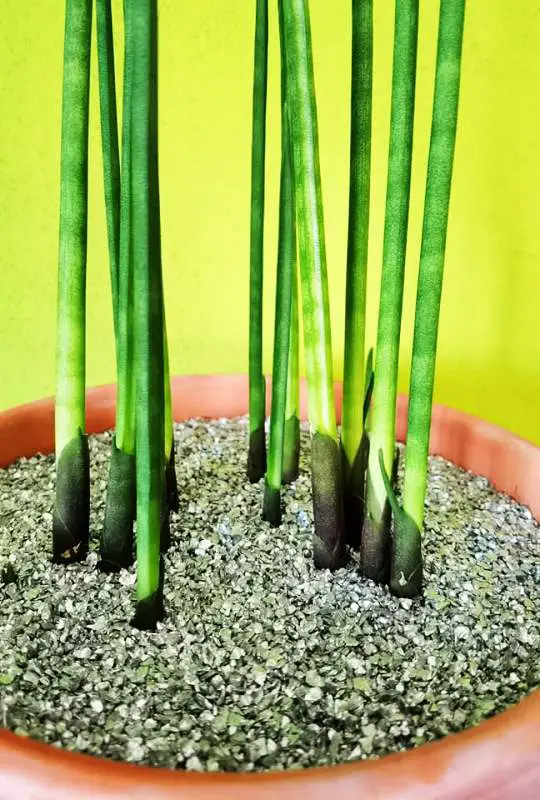
Sansevieria Bacularis grows dark purple basal leaves.
Sansevieria Bacularis Care
Light Requirements
| Minimal amount of light: | 50 lux (5 FC) |
| Optimal amount of light: | 750+ lux (75+ FC) |
| Direct sun tolerance: | 5-6 hours |
| Category: | low-light tolerant |
Light conditions that Sansevieria Bacularis Snake Plant prefers are medium indirect light (medium light is over 750 lux / 75 foot candles) and it can tolerate 5-6 hours of direct sunlight per day. If you can’t provide these light levels, the plant can survive even in lower light, as low as 50 lux, but the new growth will be long and leggy. The more bright indirect sunlight you provide, the happier your Snake plant will be. More light enhances photosynthesis and makes the plant more resistant to pests and diseases.

Keeping the plant in front of the window instead of next to it can increase the amount of light 10 times. Make sure to provide good light conditions to your Snake Plant.
Does Sansevieria Bacularis Need Sunlight?
Sansevieria Bacularis does not need direct sunlight to thrive, it can grow healthy with medium indirect light. But it can also tolerate light conditions with a few hours of direct sunlight on a daily basis.
Can Sansevieria Bacularis Tolerate Very Low Light?
Yes, Sansevieria Bacularis can tolerate very low light, as low as 50 lux. It will live in low light, but it will not thrive under those light conditions. In low light new growth will be small and leggy and the leaves will be etiolated (stretched). For a healthy and good looking Snake Plant, aim for medium indirect light (light over 750 lux).
Water Needs
Water Sansevieria Bacularis once the soil is fully dry, all the way to the bottom of the pot. To check the soil, stick a chopstick inside it, push it gently all the way down, and pull it out. If the chopstick comes out dry, with no soil attached to it, it’s time to water. If the chopstick comes out wet or dirty, with soil attached, this means the soil is still wet and you should hold off with watering. If you’re unsure, wait another week. With Snake plants, it’s always better to go on the side of underwatering. They are drought-tolerant and can survive even a few months without water if needed.
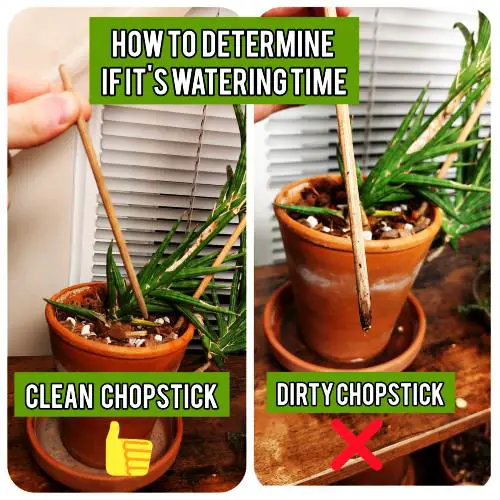
A clean, dry chopstick means that it’s time to water the plant (left), and a wet chopstick with soil stuck on it means that it’s too early to water
Humidity Needs
The optimal humidity for Sansevieria Bacularis is between 5% and 25%. However, this Snake plant adapts well to any humidity level. Even if the humidity in your home is over 70%, your plant will do just fine.
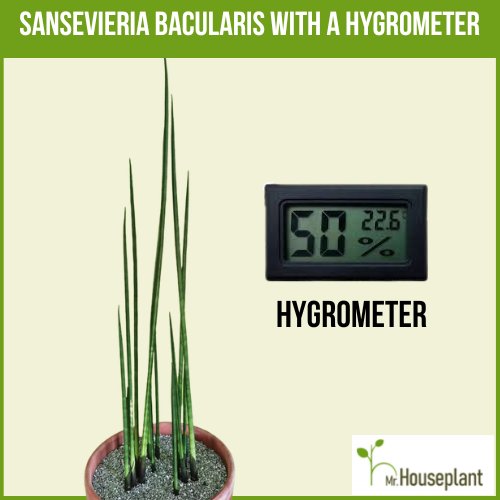
Hygrometer is a great tool that helps you check the humidity in your environment
Temperature Requirements
The optimal temperature for Sansevieria Bacularis aka Dracaena Bacularis is between 18 to 24C° (65 to 75F°). Avoid temperature drops below 16C° (60F°). They will not harm the Snake Plant but will slow down root development and leaf development.
Fertilizing
Fertilize Sansevieria Bacularis with a low-nitrogen succulent fertilizer once every 2 to 4 weeks. When fertilizing, make sure to follow the instructions on the fertilizer packaging and do not use more fertilizer than listed on the packaging.
An excellent succulent fertilizer is Espoma Succulent and Cacti Fertilizer. It is a low-nitrogen fertilizer with an N-P-K ratio of 1-2-2.
Please note that fertilizing these Sansevieria plants is not necessary if you repot the plant annually. By repotting annually, you will be providing fresh soil for the Snake plant which contains a sufficient amount of nutrients.
Never fertilize a plant when it’s not growing. Since the plant won’t be able to use the nutrients, they will accumulate in the soil. And over time, they can burn the roots and damage the plant. So, it’s best to fertilize it during its growing season.
Soil
The best potting soil for Sansevieria Bacularis is soil that dries out quickly between waterings. This type of soil is called well-draining soil. You can make this potting soil mix consisting of 1 part of any store-bought potting mix and 1 part perlite, pumice, or coarse sand.
Store-bought potting mixes in most cases are not well-draining. They retain too much water. This means the soil dries out much slower which increases the chances of root rot. That’s why you need to amend them with perlite, pumice, or coarse sand to make them well-draining.
Another disadvantage of store-bought potting mixes is they mostly consist of peat moss or coco coir. Peat moss and coco coir consist of very tiny particles. These particles compact over time. When they get compacted, there isn’t much room for oxygen. And the lack of oxygen is the perfect environment for the development of bacteria or fungi that can cause root rot.
Repotting
To repot Sansevieria plants follow these steps:
- Take the Snake plant out of its pot
- Lightly loosen the rootball
- Inspect the roots
- Cut off dead, soft, mushy roots if there are any
- Fill up 1/3 of the new pot with fresh potting soil (choose a pot with a drainage hole)
- Place the snake plant into the new pot
- Fill the pot with potting soil
- Press the soil lightly around the Snake plant
- Water if the soil has been dry before repotting
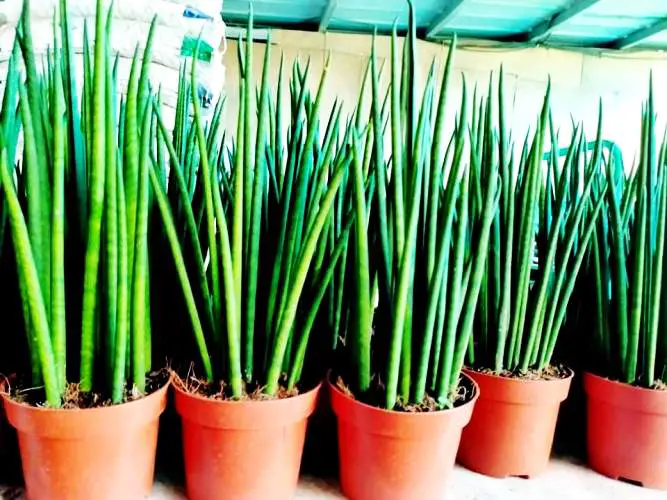
Individual leaves potted together are called Sansevieria Bacularis Mikado
Toxicity To Pets
Snake plants contain saponin which is toxic to pets if ingested, according to the American Society For Prevention Of Cruelty To Animals (ASPCA). They aren’t lethal but can cause great discomfort to your furry friend. The usual symptoms are severe pain, vomiting, nausea, increased saliva, and diarrhea. So, unfortunately, the Sansevieria Bacularis plant isn’t a pet-friendly plant.
Toxicity To Humans
Bacularis plants are toxic to humans when ingested and can cause minor illnesses such as vomiting or diarrhea, according to the University of California’s Division of Agriculture and Natural Resources. Snake plants can also cause dermatitis – skin rash or irritation.
If ingested, call the Poison Control Center or your doctor.
Pruning
Healthy Sansevieria Bacularis Snake plant doesn’t need to be pruned. Only prune dead or diseased growth or if you want to take a cutting for propagation.
Flowering
Flowering requires a lot of energy and this Sansevieria Bacularis plant species will usually flower in spring/summer, if provided with sufficient light. The flowers are white and they emerge on a long stalk that grows from the center of the plant. They have six petals and a tubular shape.
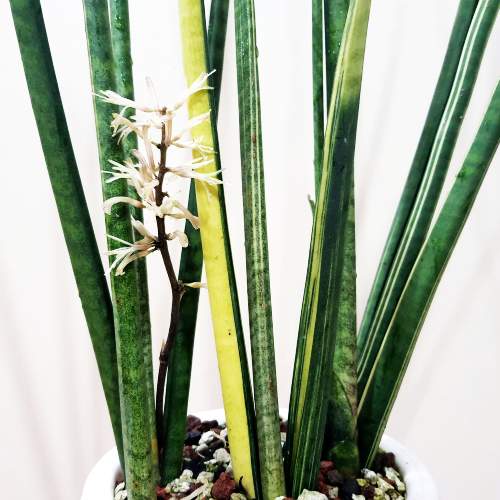
Sansevieria Bacularis plants grow tall, small, thin cylindrical leaves. This perennial stemless succulent plant species produces white flowers.
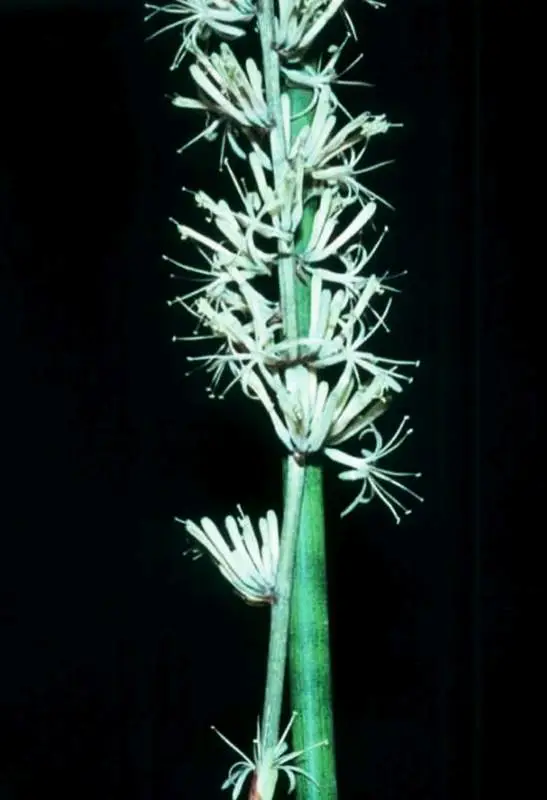
Provide good plant care for your Sansevieria Bacularis Mikado and it will flower
Propagation
You can propagate Sansevieria Bacularis Snake plant species through leaf cuttings in water or soil, division, stolon cuttings and rhizome cuttings. Continue reading for propagation tips and methods.
Leaf Cuttings In Water
To propagate Sansevieria Bacularis Snake plant through leaf cuttings in water follow these steps:
- Cut off a whole leaf (or cut off a single leaf into several sections)
- Place the cut leaf in a propagation dish with water (Make sure to keep the same leaf orientation. If you turn a leaf upside-down, it won’t be able to absorb moisture and will die)
- Put the propagation dish in bright indirect sunlight (over 10,000 lux)
- Replace water weekly to replenish oxygen and remove harmful bacteria
- Once the cuttings grow 2-3 inches of roots, pot them in soil
- In soil, water once the soil is 100% dry
- In a few months to 1 year, a new leaf will grow
- Using a heat mat or an air pump will speed up water propagation. A heat mat will increase the temperature of the water and speed up propagation. An air pump will provide oxygen for new roots. It will also cut the propagation time in half and reduce the need to replace water.
- After a few months in the water, the cuttings will grow roots and several new shoots.
How Long Does It Take To Propagate Sansevieria Bacularis?
Sansevieria Bacularis is a slow grower plant species. It takes several months to 1 year to propagate it.
Leaf Cuttings In Soil
To propagate Dracaena Bacularis through leaf cuttings in soil follow these steps:
- Cut off a whole leaf (or cut off a single leaf into several sections)
- Fill a shallow pot with a soil mix (1 part soil, 1 part perlite)
- Pot the cut leaf in the pot (Make sure to keep the same leaf orientation. If you turn a leaf upside-down, it won’t be able to absorb moisture and will die)
- Put the pot in a warm spot with bright light (over 10,000 lux)
- Water once the soil is 100% dry
- If the soil stays wet longer than a few days, increase light and repot to a terracotta pot
- In a few months to 1 year, a new leaf will grow
Division
If your Sansevieria Bacularis has more than 1 plant in the pot, you can propagate it through division. Division is separating the two plants at the root level and potting them individually. By doing this, you will get two separate Snake plants. To propagate this Snake plant species through division, follow these steps:
- Take the Snake plant out of the pot
- Remove just enough soil to expose the rhizome connecting the 2 plants
- Take a sterilized knife
- Cut the rhizome in the middle, between the 2 plants. You can also break it off with your hands
- Leave both plants for a day or two so the cut rhizomes dry out
- Pot the Snake plants in individual pots
Rhizome Cuttings
To propagate Sansevieria Bacularis Snake plant you don’t have to cut off your plant’s beautiful leaves. You can use a piece of the rhizome to create a new plant. To propagate this plant through rhizome cuttings, follow these steps:
- Take the Snake plant out of the pot
- Remove soil to expose the rhizome (thick fleshy roots)
- Take a sterilized knife
- Cut off a part of the rhizome (the bigger the better)
- Leave the rhizome for a few days so the wound can heal
- Pot the rhizome in a shallow dish with well-draining soil (1 part soil, 2 parts perlite)
- Keep the pot in a warm place
- Water once every 2-4 weeks (make sure the soil is fully dry before watering and don’t let the soil stay moist longer than a week)
- In several weeks, the rhizome will develop roots
- In several months to 1 year, it will grow a new leaf
The speed of propagation and the leaf size will depend on the size of the original rhizome cutting. A bigger rhizome will have more energy and be able to produce a larger leaf.
But the key in the propagation process is to not keep the rhizome moist for longer than 1 week. You can avoid this by using a heat mat. A heat mat will increase soil temperature by several degrees. It will speed up the drying of the soil. And it will help the rhizome grow roots faster.
Pests
Scale Pests
Dracaena Bacularis Snake plant species is generally pest free, but it can occasionally get infested with scale, vine weevils and thrips. Spider mites do not seem likely to infest them. If you do learn of spider mites infesting a Sansevieria Bacuralis, let me know in the comments.
The best way to eliminate scale is by physically removing as many scales as possible and then treating the entire plant with insecticidal soap, horticultural oil, or neem oil. These products work better on soft scales than on armored scales. Since armored scales are shielded by their armor, the products may not penetrate it, so applying them when the scales are young is the most effective option. Alternatively, you can use a systemic insecticide to get rid of scales.
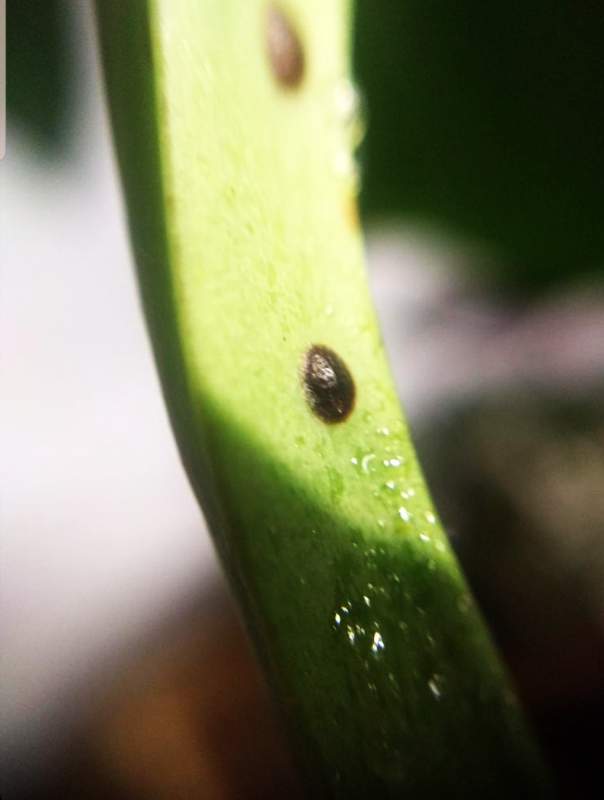
Scale pests on the Snake plant
Vine weevil
Sansevieria Bacularis Snake plant species may be attacked by vine weevils pests, if grown outdoors. Adults feed with leaves and the larvae eat roots. If you notice larvae in the soil, you can manually remove them. Check out the plant’s pot and remove the adults or you can use sticky barriers that you place around containers.
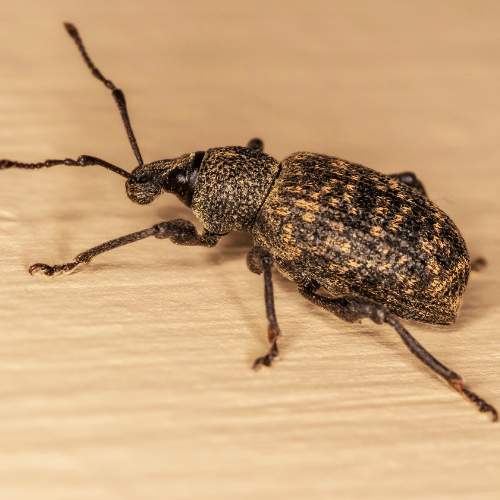
Vine weevil pest
Thrips Pests
Thrips are pests that can be challenging to get rid of. The most effective method to eliminate thrips is to use a systemic insecticide. To use this method, add 1 teaspoon of systemic insecticide per gallon of water and water the plant. The plant will take in the insecticide through the water. As thrips feed on the plant, they will ingest the insecticide and die.
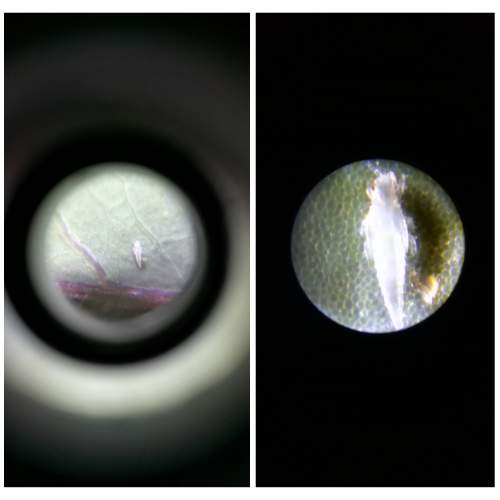
Thrips pest under the microscope
Diseases
Fungal Red Leaf Spot (Fusarium leaf spot), Southern Blight, and Bacterial Soft Rot (Erwinia carotovora) are the most prevalent diseases that affect S. Bacularis plants. Red leaf spot is identified by reddish-brown lesions with a yellow border that typically appear on young leaves when the leaves are wet and fungal spores are present. To cure an infected plant, treat with a fungicide and keep the foliage dry.
Southern Blight is characterized by water-soaked necrotic lesions on leaves close to the soil that lead to stem rot and wilting, and diseased plants should be discarded.
Bacterial soft rot is frequently seen during propagation and is characterized by mushy soft rot of the lower end of leaves, sometimes with a fishy, rotten odor. To avoid soft rot infections, keep the Sansevieria Bacularis plant leaves dry.
Common Problems
Shriveled Leaves
Underwatering is the most common cause of shriveled leaves. To remedy this, water the plant thoroughly, ensuring that the soil is fully saturated. After a day or two, the leaves should recover.
Soft and mushy leaves
Soft and mushy leaves are usually caused by overwatering, which leads to root rot. If your plant has soft and mushy leaves, remove it from the pot and remove all soil, as well as all soft and mushy roots. Repot in a new well-drained potting mix and place the plant in the brightest spot in your home.
Tips To Grow Sansevieria Bacularis Snake plant Problem Free
Here are the best tips to provide Sansevieria Bacularis Snake plant care without problems. If you stick to these Snake plant care tips, you are unlikely to experience any problems:
- Keep the Snake plant in bright light, over 750 lux (75 foot candles). Ideal lighting conditions would be light over 10,000 lux with a few hours of early morning direct sun.
- Pot in a potting mix that’s not compacted and has a lot of oxygen for the roots.
- Water once the soil is 100% dry
FAQs
How Do You Take Care Of Sansevieria Bacularis?
To take care of Sansevieria Bacularis make sure to provide it with good light conditions which are medium indirect light (over 750 lux) and water it when the soil is fully dry. Provide the optimal temperature (18C° to 24C°) and fertilize it only when it’s actively growing. These plant care tips are applicable to many Snake plant species such as Sansevieria Francisii, Whale Fin and Sansevieria Trifasciata.
Is Sansevieria Bacularis A Succulent?
Yes, S. Bacularis is a perennial stemless succulent plant that grows thin and cylindrical leaves.
Is Sansevieria Bacularis Indoor Plant?
Yes, Sansevieria Bacularis aka Dracaena Bacularis is an indoor plant.
How Big Do Sansevieria Bacularis Grow?
S. Bacularis can grow up to 7 meters (23 foot).
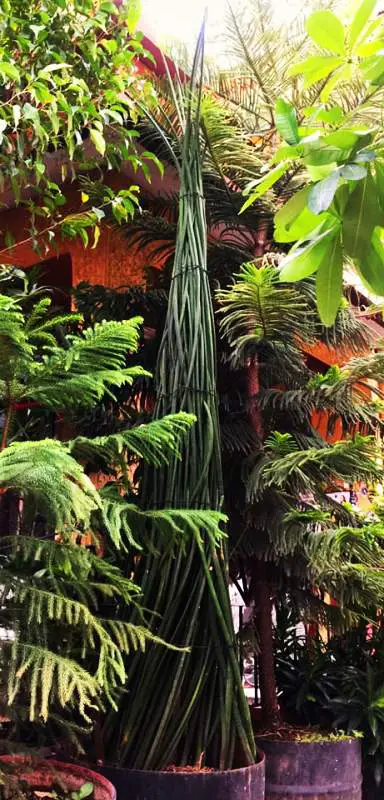
A 7-meter tall S. Bacularis. This Snake Plant is native to west central tropical Africa.
What Is The Benefit Of Sansevieria Bacularis?
The benefit of Sansevieria Bacularis is that it’s a low-maintenance plant species and is ideal for beginners. It also beautifies your home or office due to its shape and flowers.
Sansevieria Bacularis vs. Fernwood
Unlike Sansevieria Bacularis, Fernwood isn’t a single leaf plant species. Fernwood has triangle shaped leaves that are slightly bended and the tip is roundish like a pencil. S. Bacularis has a sharp tip and rounded shaped leaves.
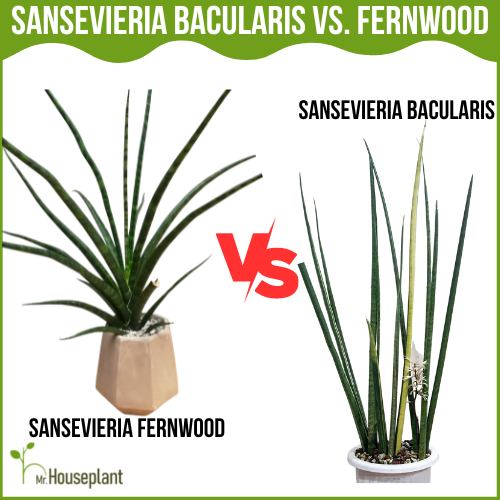
Sansevieria Bacularis plants grow tall and rounded leaves and Fernwood plants grow tall leaves in shape of triangle
Sansevieria Bacularis vs. Cylindrica
S. Cylindrica leaves are thicker with a rounder tip and they are of dark green color with light green shades. S. Bacularis has a pointed tip and its leaves are thinner. Both those plants can grow “U” shaped leaves when they are young.
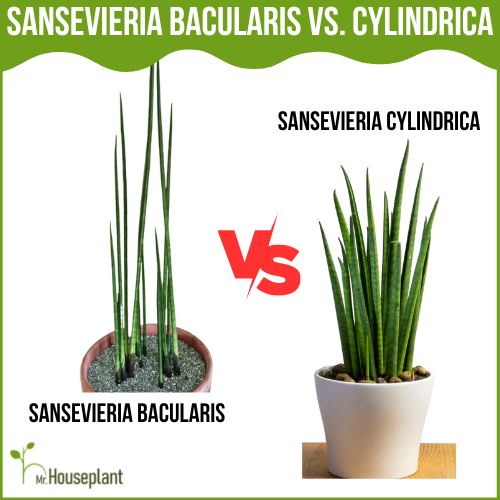
Pointed tips on S. Bacularis and rounded tips on S. Cylindrica with dark green leaves
Yours Truly,

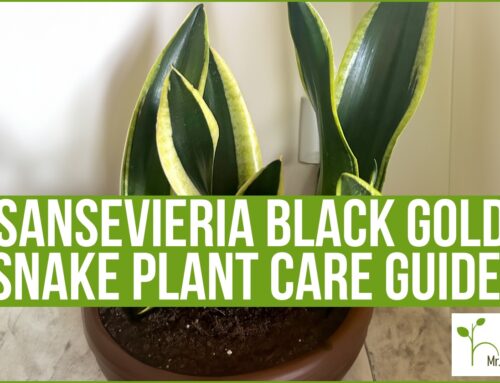




Hi! When you say they grow u shaped when young it intrigued me. Mine are growing all weird. All the babies are growing up and out instead of straight up. Will they straighten up? Is it something I’m doing? Thanks!
Hi Sandra, can you send me a photo on Instagram, I’m afraid I can’t say much until I see a photo 🙂